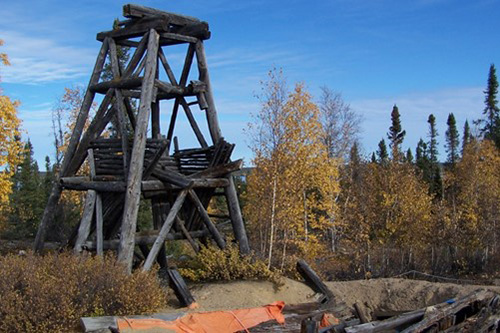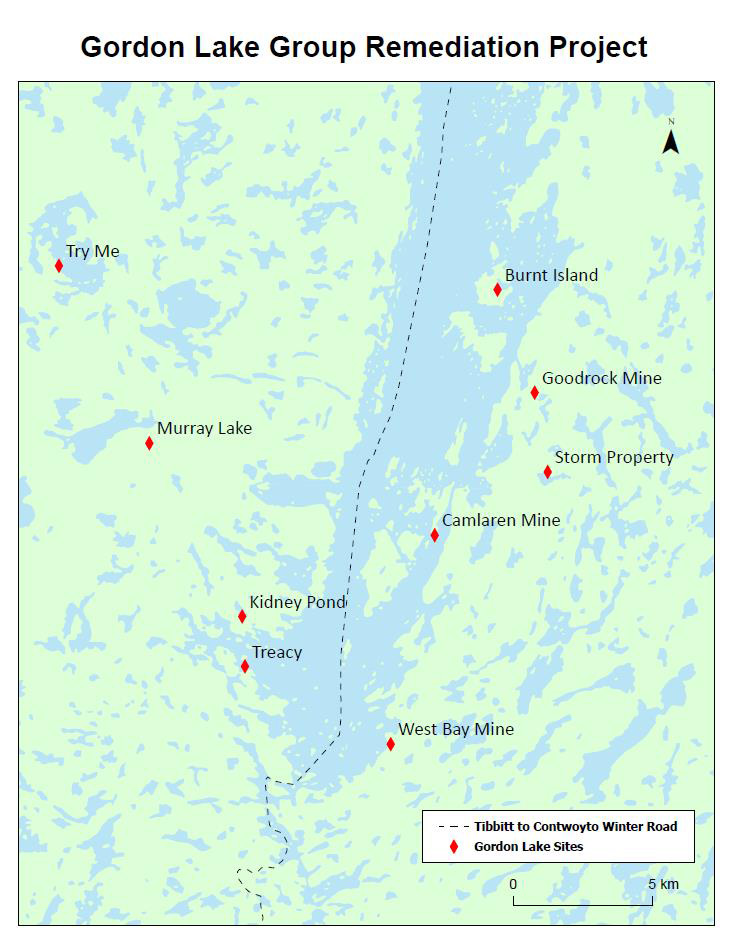Gordon Lake Group Remediation Project
Learn about the Gordon Lake Group Remediation Project, the work done to date and what's ahead.
On this page
Overview

Gordon Lake is 110 km northwest of Yellowknife. The Gordon Lake Group Remediation Project cleaned up the following sites:
- Camlaren Mine
- Burnt Island
- West Bay-Blackridge Mine
- Goodrock Mine
- Kidney Pond
- Treacy Mine
- Storm Property
- Try Me
- Murray Lake
These sites were part of a single remedial action plan because of how close they are to each other.
The largest mine was Camlaren. Mining activity for gold and tungsten began in this area in the 1940s and continued into the 1990s. 64,137 tonnes of ore were extracted and processed on site, yielding more than 36,000 ounces of gold.
The area is frequently used for hunting, trapping and other land-based activities.
Project goals

The Gordon Lake Group Remediation Project goals include:
- using approaches that are cost-effective and risk-based
- restoring the land using industry best practices of:
- science
- engineering
- Traditional Knowledge
- working with Indigenous stakeholders in all project stages to:
- regain Elder trust
- protect traditional lands and water
- planning for effective closure and monitoring, including community involvement in monitoring where warranted
Issues at the site
Even though industry cleaned up some of the Gordon Lake sites in the late 1980s, concerns remained. These included:
- abandoned infrastructure such as buildings, docks and concrete pads
- mine openings, shafts and trenches
- tailings and waste rock from mining operations
- soils impacted with metals and hydrocarbons
As a result, prospector's cabins and exploration camps were added to the assessment of the 9 sites. The historical significance to mining heritage was also talked about with:
- the Yellowknife Historical Society (formerly the NWT Mining Heritage Society)
- the Prince of Wales Northern Heritage Centre
The full scope of the work needed is outlined in the Remedial Action Plan. For a copy of the plan, visit:
Engagement approach
Crown-Indigenous Relations and Northern Affairs Canada (CIRNAC) is committed to engaging with local communities to provide information about remediation processes. To meet that goal, we meet with Indigenous rights holders and stakeholders regularly to provide site updates.
Site tours
Site tours took place every summer since 2015. Indigenous rights holders and stakeholders were brought to the site to:
- see the remediation progress in action
- give input and share their insight
Community update meetings
Since remediation started in 2017, community update meetings also took place every year.
In 2019, the project team led a workshop to develop a framework to build a community-based monitoring program.
Archeological and Traditional Knowledge studies
Before remediation, archeological and Traditional Knowledge studies were carried out in the area. Consultations took place with:
- the Yellowknife Historical Society
- the Prince of Wales Northern Heritage Centre
Studies were also done in consultation with the Yellowknives Dene First Nation. They included recording items and areas of cultural or heritage significance.
Learn more: Community Engagement Plan for the Gordon Lake Group Remediation Project (PDF).
Work done to date
2020
The remediation project is in year 2 of long-term monitoring. The goal of long-term monitoring is to make sure the contaminants have been cleaned up and no longer affect:
- the land
- air
- water
- birds
- fish
- wildlife
Monitoring is carried out every year in the spring and fall. It includes:
- surface water sampling
- monitoring the tailings and soil containment area (TSCA)
- visual monitoring
These measures help make sure remedial actions are still in place and effective.
2017 to 2019
Remediation began in summer 2017 and was finished in 2018. Remediation activities included:
- removing buildings
- sealing mine openings
- consolidating and isolating contaminated soils, tailings and waste rock
- building a tailings and soil containment area (TSCA) at Camlaren
- revegetating soil
Equipment was demobilized (removed from site) in early 2019 through a winter road.
Phase 1 of long-term monitoring began in the summer of 2019. The goal of phase 1 was to make sure the site didn't pose a threat to the environment.
2016
The remediation contract was awarded to a joint venture between:
- Delta Engineering Ltd.
- Nahanni Construction Ltd.
The Mackenzie Valley Land and Water Board awarded the Land Use Permit and Water Licence for the remediation work.
The remedial action plan for the group of sites was developed based on talks with:
- First Nations
- stakeholders
2013 to 2015
Supplemental assessment activities in support of a risk assessment were carried out at the sites to help define risks to:
- human health
- the environment
2012
Work on the sites helped to:
- check if there are contaminants on the site and how much
- give remedial options
- estimate clean-up costs
Phase 3 environmental site assessments were completed at:
- Camlaren Mine
- Burnt Island
- West Bay-Blackridge Mine
- Goodrock Mine
- Kidney Pond
- Treacy Mine
Phase 1 and 2 environmental site assessments were completed at:
- Try Me
- Murray Lake
2009
Phase 2 environmental site assessments were completed at:
- Camlaren
- Burnt Island
- Kidney Pond
- West Bay-Blackridge
- Storm
- Goodrock
- Treacy Mine
What's next
Phase 1 of long-term monitoring began in 2019 and will continue until 2023.
Phase 1 includes annual water sampling and visual inspections. These activities will confirm if the selected remedial and risk management measures applied during the remediation program are still protecting human health and the environment at the Gordon Lake Group Remediation Project sites.